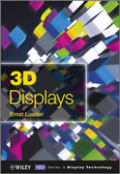
Provides an introduction to the various 3D solutions, gradually leading the reader up to the most involved 3D strategies 3D displays realized by flat paneldisplay technology and CRTs are presently a hot topic and are considered to be the next important innovation in the display market. The 3D technology included in this market introduction is known and presented in detail in the book, while the basics for the later more advanced technologies are also outlined. Introduces the reader, from first principles to an explanation of the concepts behind 3D displays, to enable the application of these concepts to the practical implementation of different types of 3D displays. Field of 3D displays is moving quickly, and is attracting increasing interest from industry and academia. Covers the key 3D display technologies, including those that have already been commercialized, as well as some promising technologies likely to see application in the future. Includes all display devices such as liquid crystal displays (LCDs), organic light-emitting diode displays (OLED), plasma display panels (PDPs) and cathode-ray tubes (CRTs). INDICE: Introduction 1. The physiology of 3D perception 1.1 Binocular viewing or the human stereopsis 1.2 The mismatch of accommodation and disparity and the depths of focus and of field 1.3 Distance scaling of disparity 1.4 Interocular cross talk 1.5 Psychological effects for depth perception 1.6 High level cognitive factor 2. Stereoscopic displays 2.1 Stereoscopic displays with area multiplexing 2.1.1 Retarders for the generation of polarization 2.1.2 Wire grid polarizers for the processing of the 2nd view 2.1.3 Stereoscopic displays with two LCDs 2.2 Combined area and time division multiplex for 3D displays 2.3 Stereoscopic time sequential displays 2.3.1 Time sequential viewing with an active retarder 2.3.2 Fast time sequential 3D displays by the use of OCB LCDs 2.3.3 Time sequential 3D displays with black insertions 2.4 Special solutions for stereoscopic displays 2.5 Stereoscopic projectors 2.6 Interleaved, simultaneous and progressive addressing of AMLCDs and AMOLEDs 2.7 Photo-induced alignment for retarders and beam splitters 3. Autostereoscopic displays 3.1 Spatially multiplexed multi-view autostereoscopic displays with lenticular lenses 3.2Spatially multiplexed multi-view autostereoscopic displays with switchable lenticular lenses 3.3 Autostereoscopic displays with fixed and switchable parallax barriers 3.4 Time sequential autostereoscopic displays and directional backlights 3.4.1 Time sequential displays with special mirrors or 3D films 3.4.2 Time sequential displays with directionally switched backlights 3.5 Depth fuseddisplays 3.6 Single and multi-view displays with a light guide 3.7 Test of 3Ddisplays and medical applications 4. Assessment of quality of 3D displays 4.1Introduction and overview 4.2 Retrieving quality data from given images 4.3 Algorithms based on objective measures providing disparity or depth map 4.3.1 The algorithm based on the sum of absolute differences (SAD) 4.3.2 Smoothness and edge detection in images 4.4 The algorithm SSIM based on subjective measures 4.5 The Kanade-Lucas-Toman (KLT) feature tracking algorithm 4.6 Special approaches for the 2D to 3D conversion 4.6.1 Conversion of 2D into 3D images basedon motion parallax 4.6.2 2D to 3D conversion based on depth cues in still pictures 4.6.3 2D to 3D conversion based on grey shade and luminance setting 4.7 Reconstruction of 3D images from disparity maps pertaining to monoscopic 2D or3D originals 4.7.1 Preprocessing of the depth map 4.7.2 Warping of the image creating the left and the right eye view 4.7.3 Disocclusions and hole filling 4.7.4 Special systems for depth based image rendering (DBIR) 5. Integral imaging (I I) 5.1 The basis of integral imaging 5.2 Enhancement of depth, viewing angle and resolution of 3D integral images 5.2.1 Enhancement of depth 5.2.2 Enlargement of viewing angle 5.2.3 Enhancing resolution 5.3 Integral videography 5.4 2D/3D convertible integral imaging 6. Holography for 3D images 6.1 Introduction and overview 6.2 Recording of a hologra
- ISBN: 978-1-119-99151-9
- Editorial: John Wiley & Sons
- Encuadernacion: Cartoné
- Páginas: 280
- Fecha Publicación: 13/01/2012
- Nº Volúmenes: 1
- Idioma: Inglés
